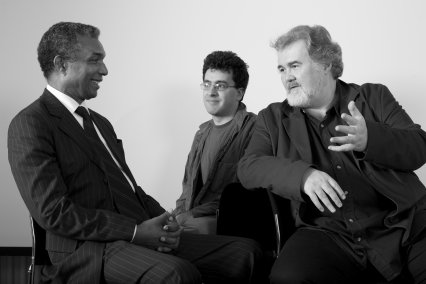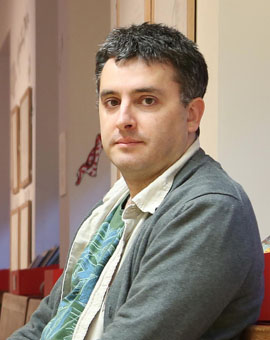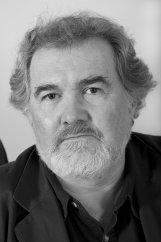The Poetry Translation Centre is pleased to present the introduction from the print edition of Eye of the Island by Corsino Fortes (tr. Daniel Hahn with Sean O’Brien), written by Daniel Hahn. He explores the collaborative translation dynamic with Sean, and the journey this book has taken to publication.
Born and brought up on the Cape Verdean island of São Vicente, Corsino Fortes studied in Portugal and spent much of his working life abroad, so while his work is concerned with giving voice to the life of his own country, its violent colonial past and possible futures, his perspective is often that of an exile, and he has haunting exile and redemptive return among his recurring themes. He writes in Cape Verdean Creole, as well as Portuguese (usually one translated into the other, occasionally blending the two together) – a choice that in itself says much about the country’s identity. Fortes began writing in the dying days of colonial rule, and he uses his work to reclaim, almost to recreate, his newly reborn country. But these are not the sort of political poems that deal with the country’s governments, leaders or freedom-fighting heroes; rather they present the living islands almost mythically – a place imbued with creative, regenerative forces.
The poems in this collection have mostly been taken from the first three of Fortes’s four published collections and come from an expanded selection published by Archipelago Books in 2015; some were originally translated for a PTC commission back in 2007. While Fortes wrote in two languages, with his blessing, our translations were mostly based on his Portuguese versions and did not distinguish between the two (I would have thought differently about this today); both languages are represented among the source poems in this volume.
I began by producing functional versions, which sought (impossibly, of course) to render each poem clearly and cleanly into English while resisting any impulse to tidy, to polish, to make any aesthetic or interpretative choices at all. My aim was not to narrow down to particular decisions, but to open up the multiple possibilities a poem could encompass. The lines were often annotated with divergent options, glosses on the source or useful background information. (“That ‘rotcha scribida’ means ‘written rock’, but NB also refers to one specific famous rock in CV with inscriptions as yet undeciphered. There’s a Cesária Évora song, too.”)
Here, for example, is my ‘literal’ of ‘Há navio morto na cidadela’:
There is (a) dead ship [=common word] in/at the citadel [citadela]
There are dead ships in/at the old city [cidade velha]
A/One child crosses the island between/amid
drums The shrub/bush gives a hand full/filled with earth
And places the seeds close to the [ten-string] guitars [sthg called a viola]
Two children go/skirt around the mouth of the riverbank [I think? – checking…]
With a rooster’s song [±cockcrow] in the vena cava
And they awake/wake
With their knuckles [in Pt it’s always ‘the knuckles of their fingers’]
The prow/bow of the/their faces
Of/From dead oars in the west
Three children go round
the steps of the district/county And
Tear/Grab/Snatch [arrancam] from the flesh
The anchors [âncoras] of finding
The ships [more literary word – eg. barques] of (the)
Discovery
These versions – useful, if ugly – were then handed over to Sean O’Brien. From that point on, my job would be to cast an eye over Sean’s work with the source in mind, and draw attention to misunderstandings, or moments where I felt the English poem had strayed too far from its Portuguese-language moorings. This is not, incidentally, a common experience for a translator; usually, we find ourselves straining slightly against the source, pulling away to see if we can get a bit more slack, but in this process I was (and I don’t mean to sound antagonistic) ‘on the same side’ as the source, pulling against the new version – the role usually reserved for the naturally protective translated writer, whose representative I had to be.
The voice in Fortes’s work is not one that renders easily in English. It’s often declamatory and dramatically musical, which can come off as, at best, a little arch and archaic, at worst portentous and hollow.
In addition, the poems use recurring imagery that likely resonated with a Cape Verdean reader, but which more often than not have no near-mythical associations for an Anglophone one. (The recurrent motifs have implications for vocabulary, too, which suited me as their first-stage translator – I didn’t know the Portuguese words for mortar and pestle when I started the process, but having looked them up I then got to recycle them, using them again and again, in poem after poem after poem…) Many of these recurring images and words, small-scale and large – a symbology comprising pestle, guitar, sun, beach, bread… – are physical, inanimate things assigned vital and sometimes epic creative power.
The poems are strong and sonorous, inhabited by these recurring images and other potent visual moments, and unpicking each of these into its components – yes, such-and-such a word means this, but there are elements of that in it, too, and echoes of the other – was a pleasing challenge. My readings of the poems always sought to allow Sean possibilities, not close them off – they were non-committal, expansive. The harder part of the job would come next, and that would be all down to Sean.
Fortes’s poems, as Sean has written, move between “vivid observation and impassioned declamation”. The translator’s challenge, then, was “to accommodate the elevated, exclamatory character of the poems without sounding empty and inflated, as surrealism (a clear reference point) often does in English. Against this, Fortes marshals an extraordinarily subtle, sustained and powerful rhythmic life, able to speak to the auditory imagination of the non-Lusophone. The impression is of magnificently controlled lyric improvisation.”
The original PTC commission was the first time I’d agreed to translate poetry, having always doubted my own ability to make poetic lines work. I retain that doubt today, but if I understand that skill any better now, it’s from examining Sean’s versions of my translations of the Fortes work.
Here’s that same poem again:
There Is a Dead Ship at the Citadel
There are dead ships at the old city
A child crosses the island to the sound of drums
A bush offers a handful of earth
And spreads the seeds near the ten-string guitars
Two children skirt the river-mouth
At cock-crow in the vena cava
With their knuckles
They awaken
The prows of their faces
From dreams of dead oars in the west
The children wander
the stairways of the neighbourhood
And draw from the flesh
The anchors of discovery
The caravels of exploration
Often the thing that struck me when I read Sean’s renderings of Fortes’s poems, was how little he had actually changed; what struck me next, however, was how much difference those little changes had made. Opting for this word rather than that (not ship or barque, but caravel), changing the weighting of a phrase, moving the spring in the line by a syllable one way or another – and suddenly it sounded precise, deliberate, in focus. Juxtaposed lines didn’t always follow a clear thread of sense, but in such cases, what Sean privileged in Fortes’s work was what he described as “the authenticity of the rhythmic impulse”. To someone like me who had never understood how this happens, the transformation was sort of magical – no, that’s not the right word, because it wasn’t mysterious exactly, it was sort of the opposite, in fact: it was an insight into the mechanics – watching a conjuror in slow motion, one frame at a time, to see how the apparently magical effect is actually achieved.
Daniel Hahn
Pre-order your copy of Eye of the Island, out 13th May 2025, now!




